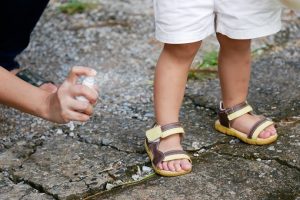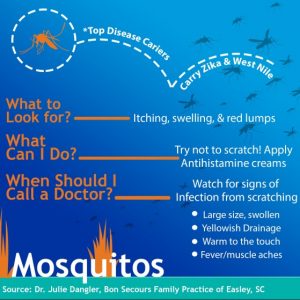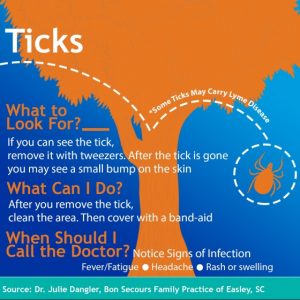Beware of Mosquitoes and Ticks
While it may seem like mosquitoes and ticks are only a summer phenomenon, the risk of being bit by either one continues well into the fall. Read on to know how to reduce your risk, check for ticks, and how to treat.
What are the risks?
Mosquitoes and ticks are known for carrying several diseases and spreading them to people through bites. Even without infections spreading, bites are often itchy and uncomfortable.
Mosquitoes may carry West Nile Virus, Zika, several types of encephalitis, and other diseases. West Nile Virus has been confirmed in mosquitoes in the Richmond area this year.
Lyme disease is the most common tick-borne disease in Virginia, but it’s not the only disease that ticks may spread. Anaplasmosis, ehrlichiosis, and Rocky Mountain Spotted Fever are all transmitted by ticks. Ticks need to be attached to you for several hours to spread any of these diseases, so promptly checking yourself for tick bites after you come in from a day outdoors will help reduce your risk.
How do you prevent bites?
Covering your wearing long sleeves and pants and using insect repellent (bug spray) with DEET helps protect against both mosquitoes and ticks, and using screens in windows and doors keeps them from getting into your home. You can spray insecticides around your home and inside your home; follow manufacturer instructions for safety, including what is safe near small children and pets.
Some types of mosquitoes are only active at dawn and dusk, while others are active all day. Putting an insecticide in standing water such as puddles or empty flower pots can help prevent mosquitoes from breeding. Water must stand for at least a week before mosquitoes can breed in it.
Ticks are common in areas with high grass or in wooded areas; your pet may get a tick and may pass the tick on to you. Wear permethrin-treated clothing and shoes to further deter ticks and prevent tick bites. Check yourself, your children, and your pets after you come in from areas where ticks may be present.
How do you treat bites?
Although it is difficult, try not to scratch the bite as that makes it itch more. Use over-the-counter antihistamines or calamine lotion to reduce the itch.
If you get a fever, headache, muscle aches, fatigue, joint pain, or vomiting after a mosquito bite, contact your primary care provider. Some mosquito-borne diseases may be treated with medicines, but many others have no treatment other than supportive care for symptoms. Survivors may have lifelong disabilities. Preventing infection by preventing mosquito bites is therefore extremely important.
If you find a tick on your skin, removing the tick quickly and completely is the first step. Regular tweezers that you already have around the house work well. If you are unable to see well or to reach the tick yourself, a friend or family member should help you.
According to the CDC:
- Use clean, fine-tipped tweezers.
- Grasp the tick, using tweezers, as close to your skin as possible.
- Pull upward with steady, even pressure. Don’t jerk. If the mouth parts remain in your skin, try to remove them; if you can’t, leave them alone.
- Dispose of the tick by putting it in alcohol, a sealed bag or container, wrapping it tightly with tape, or flushing it down the toilet. Do not try to crush it with your fingers.
- Thoroughly clean the bite area and your hands with rubbing alcohol or soap and water.
Be aware of rashes and fevers in the days and weeks following a confirmed or suspected tick bite. If you start to feel unwell, go see your primary care provider as soon as possible. Let them know the location of the tick bite, when you received the tick bite, and suspected duration of the tick bite. Many tick-borne diseases can be effectively treated with antibiotics if caught early enough, but may cause severe disability or death if untreated.
If symptoms occur, contact your primary care provider or schedule an appointment online with healthcare provider near you by going to BonSecours.com/Schedule.
Sources: Centers for Disease Control and Prevention and Virginia Department of Health



Comments are closed